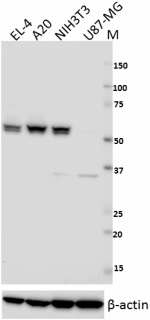- Clone
- 6G4C18 (See other available formats)
- Regulatory Status
- RUO
- Other Names
- Retinoid related orphan receptor alpha, RORA, Nuclear receptor RZR-alpha, Nuclear receptor subfamily 1 group F member 1 (NR1F1), Nuclear receptor ROR-alpha
- Isotype
- Mouse IgG2b, κ
- Ave. Rating
- Submit a Review
- Product Citations
- publications

-

Total lysates (15 µg protein) from EL-4, A20, NIH3T3 and U87-MG cells were resolved by electrophoresis (4-20% Tris-glycine gel), transferred to nitrocellulose, and probed with 1:500 diluted (1 µg/mL) purified anti-RORα antibody, clone 6G4C18 (upper). Proteins were visualized using 1:3000 diluted HRP goat anti-mouse-IgG secondary antibody (clone Poly4053) and chemiluminescence detection. Direct-Blot™ HRP anti-β-actin Antibody (1:2000 diluted, clone 2F1-1) was used as a loading control (lower). Lane M is the MW ladder.
| Cat # | Size | Price | Quantity Check Availability | Save | ||
|---|---|---|---|---|---|---|
| 683102 | 100 µg | 347 CHF | ||||
Retinoid related orphan receptor alpha, also known as RORα, is a NR1 Thyroid Hormone Like Receptor. Three different subtypes have been discovered: RORα, RORβ, and RORγ. RORα plays a key role in the development of the cerebellum. The deletion of RORα in mice causes severe impairment in the differentiation of cerebellar Purkinje neurons and results in the "staggerer" phenotype. RORα has been suggested to participate in the regulation of a number of other physiological processes, which include bone formation. Recently, RORα was reported to regulate lymphocyte development and mediate Th17 differentiation synergistically with RORγ.
Product DetailsProduct Details
- Verified Reactivity
- Mouse
- Antibody Type
- Monoclonal
- Host Species
- Mouse
- Immunogen
- Partial recombinant protein (isoform 1, 101-308 a.a.) expressed in E. coli.
- Formulation
- Phosphate-buffered solution, pH 7.2, containing 0.09% sodium azide.
- Preparation
- The antibody was purified by affinity chromatography.
- Concentration
- 0.5 mg/ml
- Storage & Handling
- The antibody solution should be stored undiluted between 2°C and 8°C.
- Application
-
WB - Quality tested
- Recommended Usage
-
Each lot of this antibody is quality control tested by Western blotting. For Western blotting, the suggested use of this reagent is 0.5 - 2.5 µg per ml. It is recommended that the reagent be titrated for optimal performance for each application.
- Application Notes
-
RORa has two isoforms, 53 kD and 59 kD, and this antibody recognizes both isoforms.
This antibody does not recognize human.
- Product Citations
-
- RRID
-
AB_2566748 (BioLegend Cat. No. 683102)
Antigen Details
- Structure
- 523 amino acids with a predicted molecular weight of 59 kD. RORs contain four major functional domains: an amino-terminal domain, DNA domain (DBD), a hinge domain, and a ligand-binding domain (LBD).
- Distribution
-
Nucleus.
- Function
- RORα can bind as a monomer or homodimer to hormone response elements upstream of several genes to enhance the expression of those genes.
- Interaction
- RORα interacts with p300, beta-catenin, HIF1A, NCOA2, CEBPB, FOXP3, and NRIP1.
- Biology Area
- Cell Biology, Transcription Factors
- Molecular Family
- Nuclear Markers
- Antigen References
-
1. Giguere V, et al. 1994. Genes Dev. 8:538.
2. Atkins GB, et al. 1999. Mol. Endocrinol. 13:1550.
3. Dzhagalov I, et al. 2004. 173:2952.
4. Yang XO, et al. 2008. Immunity 28:29.
5. Lee JM, et al. 2012. Mol. Cell 48:572.
6. Solt LA, et al. 2012. Trends Endocrinol Metab. 23:619. - Gene ID
- 6095 View all products for this Gene ID
- UniProt
- View information about RORalpha on UniProt.org
Related FAQs
Other Formats
View All RORα Reagents Request Custom Conjugation| Description | Clone | Applications |
|---|---|---|
| Purified anti-RORα | 6G4C18 | WB |
Compare Data Across All Formats
This data display is provided for general comparisons between formats.
Your actual data may vary due to variations in samples, target cells, instruments and their settings, staining conditions, and other factors.
If you need assistance with selecting the best format contact our expert technical support team.
-
Purified anti-RORα

Total lysates (15 µg protein) from EL-4, A20, NIH3T3 and U87...

 Login / Register
Login / Register 







Follow Us